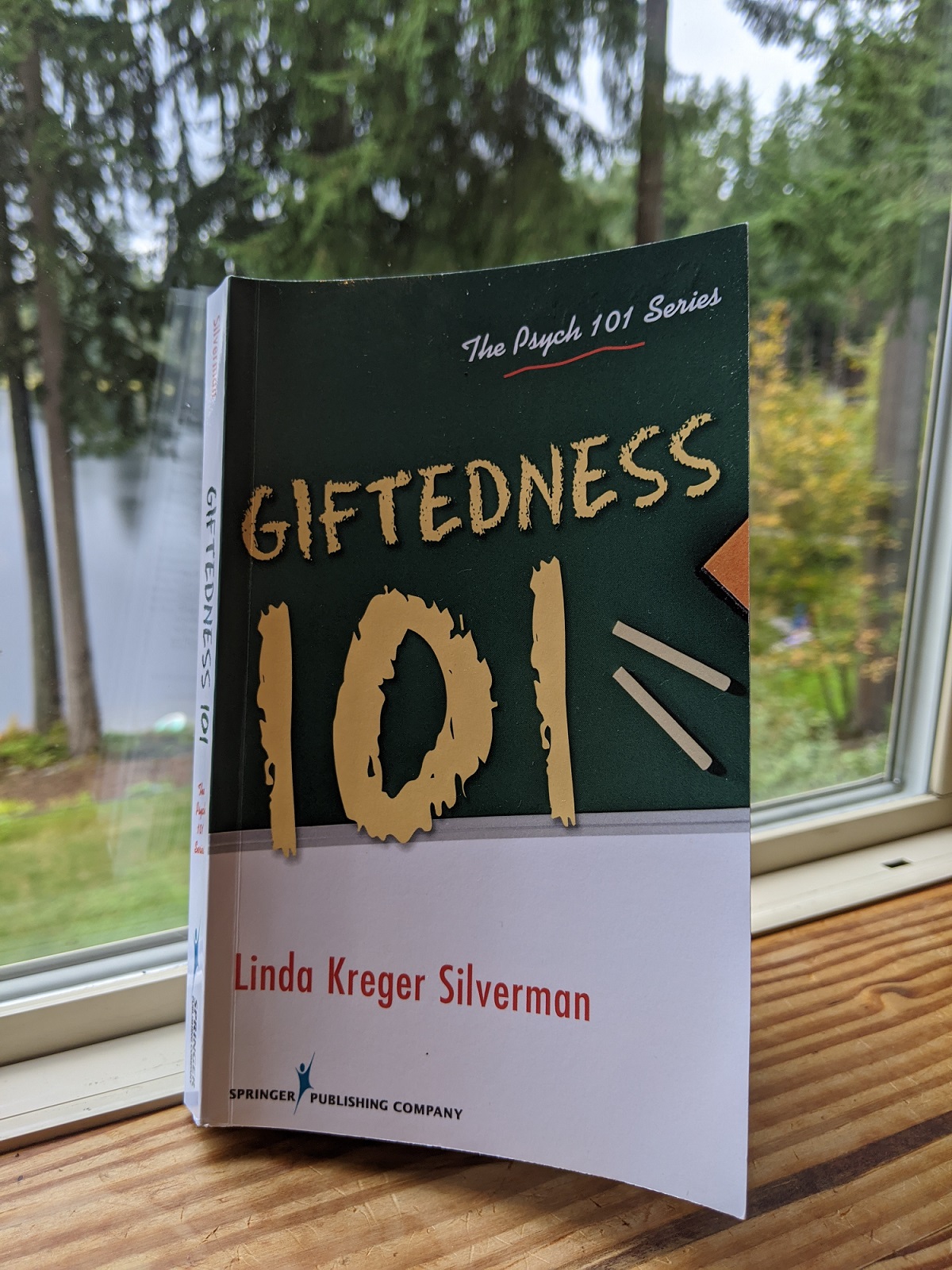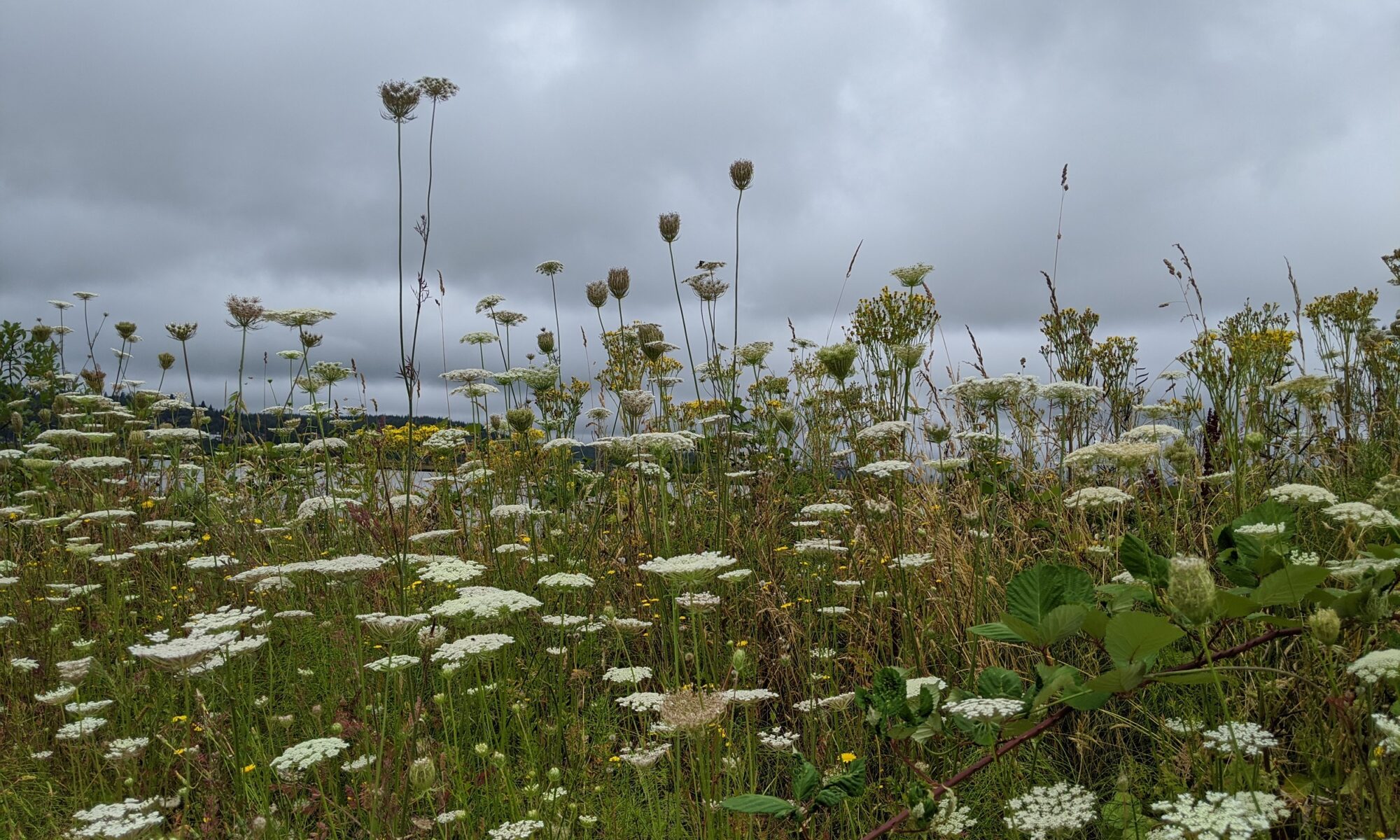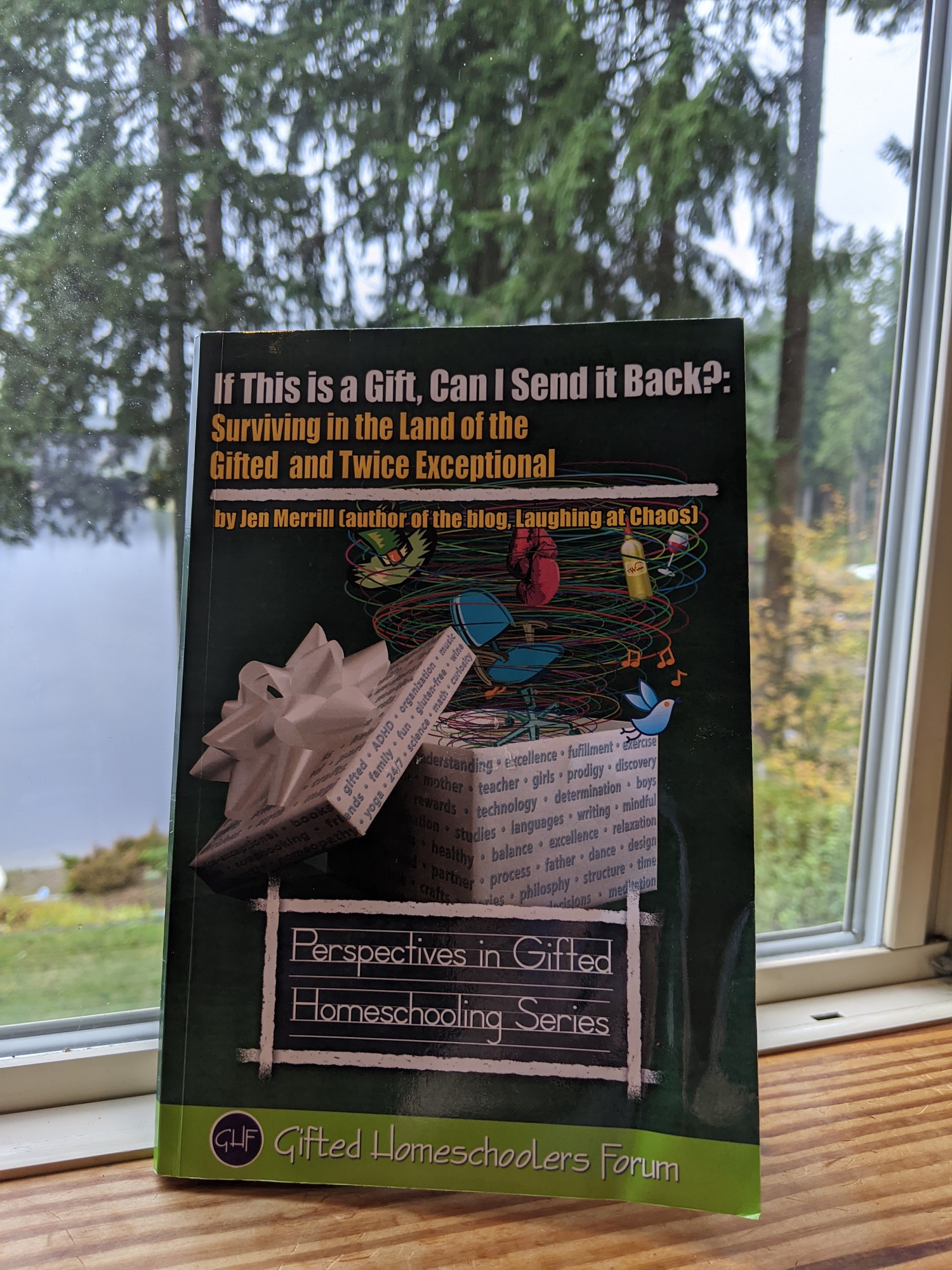 This is the first entry in what I hope will be an ongoing series of reflections on books related to giftedness and 2E learning.
This is the first entry in what I hope will be an ongoing series of reflections on books related to giftedness and 2E learning.
After listening to a Mind Matters podcast interview with Linda Kreger Silverman – Episode 20, entitled “IQ Isn’t Everything: Reevaluating Evaluation” – I ordered and read Silverman’s Giftedness 101 (2013) by Springer Publishing.
This book is part of a series of “Psych 101” books, described on the back cover as “short, reader-friendly introductions to cutting-edge topics in psychology… for all students of psychology and anyone interested in the field”.
The chapter titles alone were enough to pull me in:
- Invisible Gifts
- What is Giftedness
- The Crusade to Vanquish Prejudice Against the Gifted
- Life at the Extremes
- The Psychology of Giftedness
- Comprehensive Assessment of Giftedness
- Optimal Development of the Gifted
- Where Do We Go From Here?
While I couldn’t help turning immediately to chapter 3 (what a tantalizing title!), I quickly realized I should start at the beginning and work my way through – which I did, in concentrated chunks over the last few days. I marked up pages like mad with my pencil, and will share a few of my thoughts – accompanied by quotes – from each chapter.
Chapter 1: Invisible Gifts
“Undetected ability is an immense loss to society; the pain borne by the individual is beyond measure” (p. 2).
Silverman’s poetic first chapter makes a case for the fact that giftedness is often hiding under the surface of the small percentage of individuals who stand out through their “eminence” – indeed, one of the most commonly used strategies to cope with giftedness is “invisibility”.
“Without being given the opportunity to soar, [gifted kids] disappear into daydreams. Thousands of extremely gifted children become so disillusioned that they drop out of school and insist on being homeschooled” (p. 6).
As the quotes selected above indicate, the consequences of not acknowledging and supporting gifted kids can be dire – both societally and individually. Although my own giftedness was recognized at a fairly early age (through elementary school testing) – and I was placed in a weekly pull-out program – I didn’t receive counseling or other emotional support. I ended up developing a life-threatening eating disorder at the age of 12, and dropping out of school in the first semester of 7th grade. I only made it through morning classes in 9th and 10th grade before formally dropping out of K-12 schooling for good.
I insisted on being homeschooled – actually, on being an autodidact – and became obsessed with forming my own curricular path based on my unique passions and interests. This included several part-time jobs out in the “real world”, where I deeply appreciated the chance to interact with adults rather than teenagers. (My best friend was 20 years older than me.) I made it through my teenage years, just barely – but I sure wish I’d had more support earlier on.
Chapter 2: What is Giftedness?
“Giftedness is a political football” (p. 20)
In this chapter, Silverman discusses the fascinating history of how we’ve chosen to define giftedness over the decades – and the ramifications this has had on both identification and services. While she notes that emphasis was previously placed on “eminence” (that is, gifted kids who “achieve their potential” in society), she points out how problematic this is on so many fronts.
Silverman prefers viewing giftedness as “asynchronous development”, with a focus on training “therapists and counselors who understand [gifted kids’] inner worlds and the role that giftedness plays in their identity development” (p. 49). She points out that while giftedness studies originated in psychology, they’ve drifted away towards the education realm (i.e., talent development) – and she posits that psychologists have a moral imperative to step back into the fray.
The quote I selected from this chapter stood out to me given my own professional journey in education, and how I’ve been forced to “take sides” one way or another given the political tides at play. I’m hopeful that once Marc Smolowitz’s documentary “The G Word” can finally be released, it will provoke a much-needed and overdue societal discussion about how to best meet diverse gifted kids’ needs.
Chapter 3: The Crusade to Vanquish Prejudice Against the Giftedness
“Stereotyping the gifted is commonly accepted and, in the past, has mushroomed into scapegoating… and persecution” (p. 67).
In Chapter 3, Silverman provides additional historical context for giftedness – including wading into the decidedly unpleasant waters of Sir Francis Galton’s founding of eugenics (boooooooo!) while also covering the trajectory of work by Alfred Binet, Lewis Terman, and Leta Hollingworth (who coined the challenge of “the woman problem” in giftedness – i.e., being responsibility for child-bearing and caring while also nurturing one’s own gifts).
Silverman debunks numerous myths and stereotypes about gifted individuals – both old and new. Older myths include “Early ripe, early rot” and “giftedness is akin to madness”. Newer myths – still ever-present – include “all children are gifted”, “giftedness is just a manifestation of helicopter parenting”, “acceleration is socially harmful”, “gifted programs are elitist”, and “gifted kids can make it on their own”. A recent interview with my own parents reveals that they hold several of these beliefs, and that I would not have received any special services for my giftedness unless my school had provided them.
Chapter 4: Life at the Extremes
“The higher the individual’s IQ, the more intense the struggle for identity, meaning, and connection” (p. 87).
In this chapter, Silverman compares and contrasts the atypical developmental needs of kids at both ends of the intellectual spectrum. She argues that just like intellectual disability, giftedness should be seen as an “organizing principle” that would allow behaviors to be “perceived within the context of those with similar abilities, rather than viewing them as ‘aberrant’ in relation to those in the average range” (p. 93). She names such challenges of extreme giftedness as advanced vocabulary (which “hinders communication”), depression, loneliness, so-called “mania” (i.e., intense focus and enthusiasm), and “perfectionism” (actually a common character trait of giftedness, rather than a defect to be overcome).
Silverman discusses the various levels of giftedness, noting that “gifted educators have been so focused on the development of talented children (approximately 120 IQ and above) that they have not taken seriously the needs of children in the higher extremes of ability” (p. 101) – many of whom are “hidden” due to being homeschooled.
Finally, in this chapter Silverman discusses giftedness throughout the lifespan, beginning with the earliest potential indicators in infancy (including the high value of early identification – especially for kids who may not otherwise be given services to nurture their gifts), and giftedness in adults – which I’ve written about quite a bit already on this blog. (Naturally, much of this portion of the chapter is heavily underlined… )
Chapter 5: The Psychology of Giftedness
“It is time for a psychology of giftedness – time to recognize the developmental differences, personality traits, lifespan development, particular issues and struggles of the gifted, as well as the consequences of not being acceptable” (p. 121).
Silverman covers quite a few topics in chapter 5, including: feeling different (and what this means for “stages of friendship”); gifted kids’ quintessential adaptability (“Who would you like me to be today?”); the inner experience of being gifted; Dabrowski’s “theory of positive disintegration”; perfectionism (both healthy and unhealthy); and introversion.
So many ideas in this chapter resonated with me – perhaps most especially the idea that gifted kids “quickly learn what is expected of them and how to elicit the responses they desire from adults” (p. 129). This was enough the Story of My Childhood that I’ll devote a specific blog post to it later on, since it played a pivotal role in my eventual disintegration into an eating disorder and “failure to thrive”. Briefly, I spent so many years being who others thought I was – or wanted me to be – or needed me to be – that I was unable to make it safely across the bridge of adolescence without crashing and burning numerous times.
In Silverman’s discussion about the “inner experience of giftedness”, countless ideas stood out; here are just a few, rat-a-tat:
“Excitement with new insights is dampened when there’s no one with whom to share them. Social exchange becomes a minefield when one is attuned to a symphony of nuance” (p. 131).
“It isn’t fun or funny to be laughed at for who you are. The dread of being ‘abnormal’ impels the gifted to lead a double life. They feign normalcy attempting to mask their vulnerability” (p. 132).
“Anti-intellectualism, under the guise of egalitarianism, is pervasive worldwide” (p. 132).
“The tall poppies syndrome is a social phenomenon of attacking those with exceptional ability” (p. 133).
“Benign neglect of the gifted is customary, with the rationale that they can take care of themselves and other students are in more need” (p. 133).
Yikes – and, yes!
Silverman undeniably has her pulse on the inner worlds of gifted kids – and how many challenges they face that most would consider insignificant. It’s tiring “feigning normalcy”, feeling unheard, trying not to “stand out”, and knowing that your needs are considered much less important than others’.
However, I really stood up and took notice during the next portion of this section, in which Silverman discusses various “personality characteristics” associated with gifted kids – and I saw my own challenging history in each one:
First:
“The gifted are gullible. Their first inclination is to be truthful, so they tend to believe nearly anything anyone tells them… Early humiliations leave deep scars…” (p. 134).
I was relentlessly bullied (by my so-called friends) in second grade, and will write about that in a separate post – but yes, the scars ran deep.
Second:
“When gifted individuals cannot find anyone who understands their reality, they begin to doubt their sanity” (p. 134).
Because others “do not observe, apprehend, feel, experience, or intuit in the same manner” as gifted kids, they may tend to feel “gaslit”. So interesting. I hadn’t made that connection before, but it rings very true.
Third:
Gifted kids tend to have a “logical imperative”, leading to “imposter syndrome” because they:
“… compare their knowledge with all there is to be known about a subject” and “soon become aware that they’ve barely scratched the surface… The gifted often feel like they’ve just fooled everybody into thinking that they are smart, and at any moment they will be found out” (p. 135).
Ummm… Yes. Exactly. And, making things even worse:
“The gifted hate hypocrisy and they have uncanny perception, which often puts them at odds with bosses, co-workers, teachers, and parents who sport inauthentic facades” (p. 135).
I can’t stand in-authenticity!!!! I’ve had to intellectualize and compartmentalize its social necessity in order to function. (FWIW, studying sociology and evolutionary psychology has been a godsend for this.)
Furthermore, Silverman notes:
“[Gifted kids] are paradoxical: self-assured and insecure, bold and timid, idealistic and practical, compassionate to others and unkind to themselves, mature and immature” (p. 135).
How is it that so many contradictions mutually co-exist? And yet, they do.
Moving on, Dabrowski’s work deserves its own blog post, especially given how much controversy there is in the “gifted world” around his concept of “overexcitabilities” or OEs. Perfectionism and introversion are also blog-worthy entries in their own right, so I’ll also pause on those for now.
Chapter 6: Comprehensive Assessment of Giftedness
“IQ scores are never an end in themselves; they are simply tools to be used wisely in the hands of professionals who understand giftedness” (p. 190).
As someone completely unversed in psychometrics, I learned the most from – and feel most humbled by – this chapter. There is a LOT that goes into accurately assessing giftedness, and I finished this chapter with more questions than answers. This is clearly a growth area for me; in the meantime; I’m grateful for all the individuals who dedicate their lives to doing this important work, and doing it well.
Chapter 7: Optimal Development of the Gifted
Silverman begins her penultimate chapter by emphasizing the need to stop “bashing” parents of gifted kids, instead focusing on the critical role they play in their children’s development – and pointing out that they need support (yes!).
She discusses how to foster an optimal home environment (primarily by being responsive to kids’ needs and interests) and the fact that giftedness tends to “run in families”. (Unfortunately, she seems to take genetic relatedness among all members for granted, which is far from always the case; or, if I’m misreading her, the importance of environmental influences rather than or in addition to heritability should be called out more explicitly.)
She also briefly covers elements of an “optimal school environment”, which among other things boils down to listening to what kids want and need – and then listening some more.
Chapter 8: Where Do We Go From Here?
Silverman’s short closing chapter is a “call to work” for fledgling psychology students to join the fray of the giftedness sphere – which she acknowledges has “no truce in sight”. She reminds the reader:
“If the gifted and twice exceptional should become your passion… you will be paid in appreciation. Your work will be a wellspring of creativity. You’ll be outside the box anyway, eyed suspiciously by the system, so you might as well enjoy the freedom to access your creativity” (p. 232).
I appreciate that Silverman doesn’t sugarcoat the realistic challenges of working with and for gifted individuals. I’m writing this blog anonymously (for now) for a reason. I need more time to make peace with my passion for giftedness – which has always been there, but wasn’t allowed to blossom until I finally had kids of my own and needed to find ways to help them.
In closing, I recommend Giftedness 101 for anybody just stepping into this world, who wants a concise yet compassionate overview of where we’ve been, where we’re at, and where we should head.
As Silverman notes, there’s plenty of work left to do.
References:
- Silverman, L. (2013). Giftedness 101. Springer Publishing.
Copyright © 2020 by HalfoftheTruth.org. Please feel free to share with attribution.
 I started this blog in August of 2020, five months after the COVID-19 pandemic began. We were living through such extraordinary times that I wanted to document some of my thoughts on what navigating that was like, particularly as a parent.
I started this blog in August of 2020, five months after the COVID-19 pandemic began. We were living through such extraordinary times that I wanted to document some of my thoughts on what navigating that was like, particularly as a parent.









 This is the first entry in what I hope will be an ongoing series of reflections on books related to giftedness and 2E learning.
This is the first entry in what I hope will be an ongoing series of reflections on books related to giftedness and 2E learning.